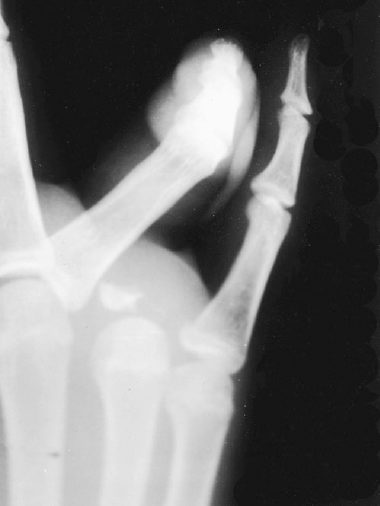50
Volar Metacarpophalangeal Dislocations (Irreducible)
Benjamin Chang and Mark Katz
History and Clinical Presentation
A 17-year-old boy was grabbed by the left ring finger during an altercation and the finger was twisted. He noted immediate pain, swelling, and deviation of the finger. He came to the emergency department on the same day for treatment.
Physical Examination
The patient’s ring finger was ulnarly angulated, shortened, slightly hyperextended at the metacarpophalangeal (MP) joint, and flexed at the proximal interphalangeal (PIP) joint. There was no active motion at either joint. The skin was intact. The base of the proximal phalanx was prominently palpable in the palm and deviated to the radial side. Sensibility and capillary refill were normal. The remainder of the upper extremity was nontender.
Differential Diagnosis
Dislocation Volar MP joint
Simple
Complex Dorsal MP joint
Simple
Complex
Sprain of the MP joint
Fracture of the distal metacarpal
Fracture of the proximal phalanx
PEARLS
- If the mechanism is a hyperextension, then think an injury to the distal volar plate avulsion and plan a volar surgical approach
- If the mechanism is a hyperflexion, then suspect a proximal dorsal capsule interposition and plan a dorsal surgical approach
PITFALLS
- The digital nerves are displaced by the dislocation and are more prone to iatrogenic injury from the volar incision.
- Prolonged postoperative immobilization in the absence of a fracture is unnecessary and leads to stiff joints.
Diagnostic Studies
Radiographs of the hand revealed a fracture/dislocation of the MP joint with ulnar deviation of the ring finger and radial displacement of the base of the proximal phalanx on the posteroanterior view (Fig. 50–1). The lateral view clearly demonstrates the volar dislocation of the proximal phalanx relative to the metacarpal head (Fig. 50–2). An oblique view was also obtained.
Diagnosis
Volar Intraarticular Fracture/Dislocation of the Ring Finger MP Joint
The radial collateral ligament is presumably still attached to the small fracture fragment, but the ulnar collateral ligament must be completely disrupted to permit this degree of displacement.


Figure 50–2
Stay updated, free articles. Join our Telegram channel

Full access? Get Clinical Tree








